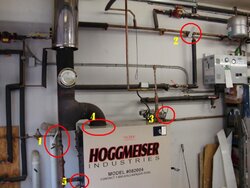Hello folks, a newby to the site here with a question about flue gas condensation.
I am hoping someone can help explain the effects of flue gas condensation to me such that I can both understand it and determine if my system is being effected by it.
Briefly, I have indoor Kerr boiler in my shop heating the infloor of both my shop and my house. During the real cold months of January and February the system is slightly undersized and requires frequent loading, even then my water/glycol will drop to as low as 110-120 degrees overnight.
In an effort to increase water temps (and reduce flue gas condensation), we have an electric boiler as well to boost the temps above 130 degrees during times of low wood boiler output.
I have read anything I can get my hands on to try to understand the relation of water temps to flu gas temps and the corrosive effects it has on the system. My user manual for the boiler clearly states the water temps must be above 130 degrees at all times in order to reduce/eliminate corrosion caused by flu gas condensation.
I (think) I understand the concept, but I still have some questions that I hope the more experienced here can help me get my head around.
So here are few questions that if I understood better, I might then finally be able to determine what to do.
My SS chimney doesn't seem to have any condensation running down inside the pipe. Does this mean I don't have flue gas condensation?
Would I be able to see if this is happening?
I read that the corrosion will shorten the life of the boiler, if it is starting to have an effect, would I be able to determine this by looking at my boiler....ie see rust?
Does the corrosion only effect the chimney pipes?
I ask all these questions because the cost of the electric boiler is killing me ($1600 per yr) and I am trying to determine if I might be better off accepting the shorter boiler life vs paying the electric costs and just let it run at the lower temps.
Can anyone help me understand if/how my lower water temps are effecting my situation?
Thanks Canuk
I am hoping someone can help explain the effects of flue gas condensation to me such that I can both understand it and determine if my system is being effected by it.
Briefly, I have indoor Kerr boiler in my shop heating the infloor of both my shop and my house. During the real cold months of January and February the system is slightly undersized and requires frequent loading, even then my water/glycol will drop to as low as 110-120 degrees overnight.
In an effort to increase water temps (and reduce flue gas condensation), we have an electric boiler as well to boost the temps above 130 degrees during times of low wood boiler output.
I have read anything I can get my hands on to try to understand the relation of water temps to flu gas temps and the corrosive effects it has on the system. My user manual for the boiler clearly states the water temps must be above 130 degrees at all times in order to reduce/eliminate corrosion caused by flu gas condensation.
I (think) I understand the concept, but I still have some questions that I hope the more experienced here can help me get my head around.
So here are few questions that if I understood better, I might then finally be able to determine what to do.
My SS chimney doesn't seem to have any condensation running down inside the pipe. Does this mean I don't have flue gas condensation?
Would I be able to see if this is happening?
I read that the corrosion will shorten the life of the boiler, if it is starting to have an effect, would I be able to determine this by looking at my boiler....ie see rust?
Does the corrosion only effect the chimney pipes?
I ask all these questions because the cost of the electric boiler is killing me ($1600 per yr) and I am trying to determine if I might be better off accepting the shorter boiler life vs paying the electric costs and just let it run at the lower temps.
Can anyone help me understand if/how my lower water temps are effecting my situation?
Thanks Canuk


